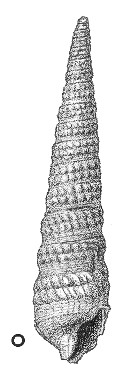
Revised descriptions of New Zealand Cenozoic Mollusca from Beu and Maxwell (1990)

 | Revised descriptions of New Zealand Cenozoic Mollusca from Beu and Maxwell (1990) | 
|
  (Pl. 30o): GS10342, Z14/f9504, Maruhou Point, east of Te Araroa, East Cape, Kapitean (GNS) |
Beu & Maxwell (1990): Chapter 13; p. 269; pl. 30 o.
Synonymy: Cerithium bicorona Hutton 1885b, p. 328; Terebra catenifera "Tate" of Suter 1915, p. 43 (not of Tate, 1889); Terebra bicorona; Acuminia bicorona; Perirhoe (Dimidacus) bicorona
Classification: Terebridae
Description: Moderately large for genus (42-55 mm high), very tall and slender, with spire angle of only 10°-15°, teleoconch with more than 15 whorls (apex missing from all specimens); whorls relatively short and wide (whorl height ranges from 0.5 to 0.7 whorl diameter). Sculpture of 2 wide, low, nodulose spiral cords below suture, occupying upper half of spire whorls; 4 or 5 low, narrow, rather indistinct spiral cords fill weakly concave space below the 2 subsutural cords; slightly more prominent cord forms weak peribasal angulation, emerging from suture of penultimate whorl; and several weak, obscure spiral threads on rapidly contracted base. Aperture incomplete in known specimens, small. Anterior canal short, twisted, with low, ridge-bordered fasciole. Protoconch not seen.
Comparison: Hutton's (1885b, p. 329) holotype of Cerithium bicorona (figured by Marwick 1924e, pl. 6, fig. 13) was said to be from "Tutaekuri River, Hawke's Bay. Collected by Mr Winkleman", but we are not aware of a soft-bottom, shelf-facies molluscan locality of suitable age within the northern lowlands of central Hawke's Bay that could be the type locality. The Tutaekuri River flows through mostly Nukumaruan mudstone and limestone, and rocks as old as Waipipian in its headwaters around the Napier-Taihape Road and Puketitiri are mostly Te Aute limestone facies. A locality in the shelf-facies Pliocene of Takapau-Dannevirke district of southern Hawke's Bay seems feasible, but the real locality and age of the type are likely to remain a mystery.
Gemmaterebra bicorona is easily recognised by being the single New Zealand terebrid with two nodulose cords below the suture. There is some evidence of two forms in the available material: specimens from Oparara River have relatively tall whorls (height 0.7 diameter) and a spire angle of only 10°, whereas Hutton's holotype (Marwick 1924e, p. 327, pl. 6, fig. 13) and specimens from Te Araroa, East Cape (Kapitean) have shorter whorls (height 0.5 diameter) and a spire angle of 15°. However, Powell's illustrations (1931a, p. 108, pl. 10, fig. 3, 4) show that South Taranaki Waipipian shells are like the markedly older Oparara River ones, with spire angles of 10°; the taxonomy needs further study.
Modern lists have followed Powell (1931a) in including G. bicorona in Perirhoe (Dimidacus), but such a position seems inappropriate. The type species of Perirhoe Dall, 1908 is Terebra circumcincta Deshayes, 1857 (living, Queensland and northern New Zealand; Powell 1979, p. 246, pl. 47, fig. 18), a species with no subsutural collar, but evenly spaced, clearly punctate spiral grooves over the whole shell (5-6 on spire whorls and 12 on last whorl). The type species of Dimidacus (Iredale 1929, p. 341), Perirhoe (Dimidacus) melamans Iredale, 1929 (Quaternary?, Sydney Harbour dredgings) is much more like New Zealand fossils, but has coarse spiral cords below the subsutural fold, and the subsutural fold is smooth, not nodulose. T. melamans appears to belong in a group close to the living T. cingulifera Lamarck (Cernohorsky & Jennings 1966, pl. 5, fig. 18, 18a). Beu & Maxwell (1990) included the New Zealand fossil in Gemmaterebra Cotton (1952, p. 239) (type species: Terebra catenifera Tate, 1898; Pliocene, southeastern Australia). The type species (many specimens examined in GNS) is a bicoronate species resembling G. bicorona (Hutton) but with smaller subsutural nodules, and this appears to be a suitable genus to include such bicoronate living species as Terebra anilis (Röding) and T. amanda Hinds (Cernohorsky & Jennings 1966, pl. 5, fig. 15-17), which do not have the evenly spaced, punctate spiral grooves of T. circumcincta. Unfortunately, Gemmaterebra is a very obscure name that has not appeared in Neave's "Nomenclator Zoologicus" or in "the Zoological Record", and so has not been adopted by most taxonomists. Its type species is similar enough to G. bicorona (Hutton) that the two were confused by Suter (1915, p. 43).
Distribution: Clifdenian?; Lillburnian-Waipipian; Mangapanian? Gemmaterebra bicorona or a close relative is an uncommon species in shallow, near-shore, sandy environments, known from Oparara River, Karamea district, southwest Nelson (Lillburnian, or possibly Clifdenian), several records from the shore platform between Te Araroa and East Cape (Kapitean), the Wanganui-South Taranaki coast (Waipipian), and Timmins Creek, Mangahao, Eketahuna district, northern Wairarapa (Waipipian or perhaps Mangapanian).
Cite this publication as: "A.G. Beu and J.I. Raine (2009). Revised
descriptions of New Zealand Cenozoic Mollusca from Beu and Maxwell (1990). GNS
Science miscellaneous series no. 27."
© GNS Science, 2009
ISBN
978-0-478-19705-1
ISSN 1177-2441
(Included with a PDF facsimile file
copy of New Zealand Geological Survey Paleontological Bulletin 58 in CD version
from: Publications Officer, GNS Science, P.O. Box 30368 Lower Hutt, New
Zealand)